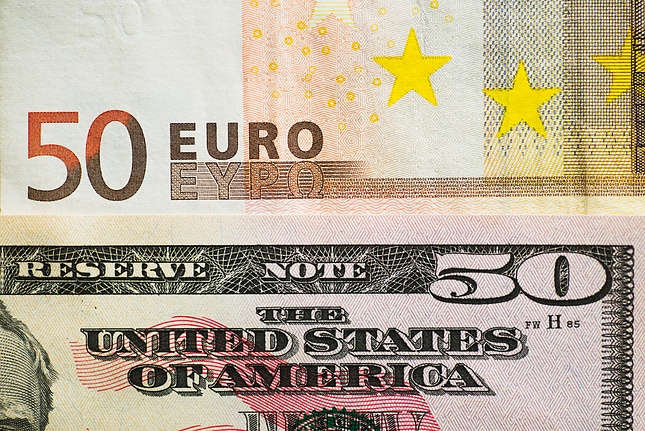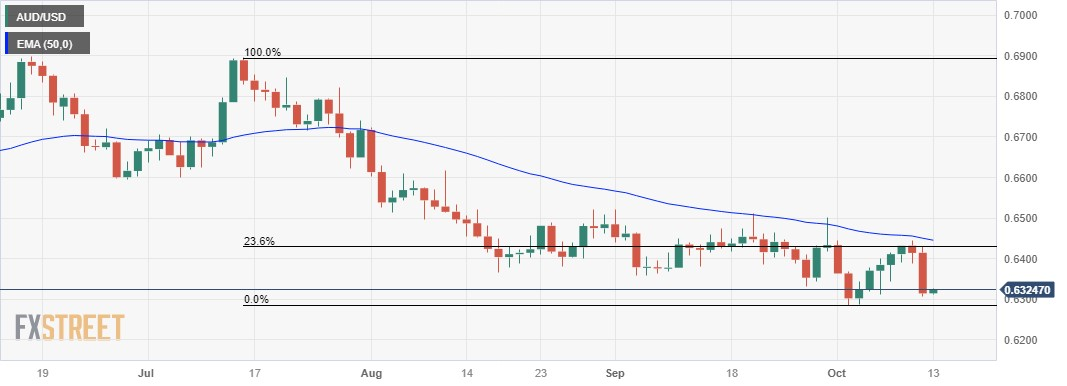- Australian Dollar moves sideways after trimming intraday gains.
- Aussie pair dipped post-release of the US headline inflation.
- Consumer Inflation Expectations raised the odds of RBA to increase interest rates.
- US Dollar advanced following the slew of upbeat US data, awaiting US Consumer Sentiment.
The Australian Dollar (AUD) snaps a two-day losing streak post a slew of optimistic economic data from the United States (US) during the week. With US inflation surpassing expectations and initial jobless claims coming in lower than anticipated, discussions about the trajectory of the US Federal Reserve's (Fed) monetary policy have been reignited.
Australia has experienced a rise in consumer expectations regarding inflation, a trend likely influenced by an increase in oil prices. The upcoming focal points include the release of Meeting Minutes from the Reserve Bank of Australia (RBA) and employment data in the next week.
This downbeat Chinese inflation data has the potential to impact the Australian Dollar, considering Australia's significant role as a major exporter to China. Economic dynamics between these two countries often influence the performance of the Aussie Dollar, and the subdued inflation figures from China may contribute to undermining its strength.
The US Dollar Index (DXY) gained upward momentum after a robust release of US data. Nonetheless, on Friday, the US Dollar (USD) is trading marginally lower, influenced by a retreat in US Treasury yields following a recent surge. Market participants are expected to redirect their attention to the Michigan Consumer Sentiment Index set to be released on Friday.
Investors seem to factor in the possibility of another Fed rate hike. This is noteworthy given the recent mixed rhetoric from most Fed officials, emphasizing the necessity for the US central bank to maintain higher rates for an extended period, even without signaling a clear intention for another rate increase.
Daily Digest Market Movers: Australian Dollar attempts to retrace recent losses on RBA interest rates trajectory
-
Australian Consumer Inflation Expectations for October have been reported at 4.8% on Thursday, showing a slight increase from the September figure of 4.6%.
-
Australia witnessed a rebound in inflation in August, largely driven by elevated oil prices. This resurgence raises the probability of another interest rate hike by the Reserve Bank of Australia (RBA).
-
The unfolding Middle East conflict adds a layer of complexity to the situation, potentially prompting the RBA to implement a 25 basis points (bps) interest rate hike, reaching 4.35% by the year's end.
-
The heightened geopolitical tension is fostering a surge in demand for commodities, particularly energy and gold. This surge is exerting a positive influence on the performance of the AUD/USD pair.
-
Australia’s Westpac Consumer Confidence showed that current buying conditions improved in October. The index rose 2.9% from the previous 1.5% decline in September.
-
The recent release of the Consumer Price Index (YoY) by the National Bureau of Statistics of China for September brought some notable figures. The reading of 0.0% came in lower than the expected 0.2% increase, compared to the previous reading of 0.1%. Meanwhile, the Producer Price Index year-over-year experienced a decline of 2.5%, surpassing the anticipated decrease of 2.4%.
-
The US Bureau of Labor Statistics (BLS) disclosed that the Consumer Price Index in the US surpassed forecasts in September. The annual basis figures expanded at a consistent rate of 3.7%, slightly exceeding estimates of 3.6%.
-
US Initial Jobless Claims for the week ending on October 6 showed a slight easing, despite an increase of 209K, which was slightly below the forecast of 210K.
-
US Producer Price Index (PPI) surged in September on a yearly basis, jumping from 2.0% to 2.2%, surpassing the anticipated 1.6%. Core PPI experienced a rise, climbing to 2.7% from the anticipated easing to 2.3%, surpassing the earlier figure of 2.5%.
-
The yields on US Treasury bonds advanced on Thursday on the back of solid US data, with the 10-year US Treasury bond yield marking the highest level at 4.72%.
-
The Federal Open Market Committee (FOMC) minutes shed light on a divergence of opinions, underlining the importance of data reliance. The consensus for additional interest rate hikes appears contingent on a significant uptick in inflation.
-
Some participants argue that as the policy rate approaches its peak, the focus should shift from the extent of rate increases to determining how long to maintain the policy rate at restrictive levels.
-
Market participants will likely monitor the US Michigan Consumer Sentiment Index on Friday. Although the Australian economic docket is empty on Friday, attention will shift to the Reserve Bank of Australia (RBA) meeting minutes and employment data scheduled for release in the coming week.
Technical Analysis: Australian Dollar holds ground above the major support level at 0.6300
The Australian Dollar trades around 0.6320, aligned to the major support level at 0.6300 lined up with a monthly low at 0.6285. The 23.6% Fibonacci retracement level at 0.6429 acts as strong resistance, followed by the 50-day Exponential Moving Average (EMA) at 0.6445 level. A clear breakthrough could pave the way for upward momentum, aiming at the psychological milestone of 0.6500.
AUD/USD: Daily Chart
Australian Dollar price today
The table below shows the percentage change of Australian Dollar (AUD) against listed major currencies today. Australian Dollar was the weakest against the Pound Sterling.
| USD | EUR | GBP | CAD | AUD | JPY | NZD | CHF | |
| USD | -0.10% | -0.16% | -0.07% | 0.01% | -0.01% | 0.22% | -0.10% | |
| EUR | 0.10% | -0.06% | 0.01% | 0.12% | 0.08% | 0.33% | -0.01% | |
| GBP | 0.13% | 0.04% | 0.06% | 0.15% | 0.13% | 0.36% | 0.04% | |
| CAD | 0.08% | -0.01% | -0.07% | 0.11% | 0.06% | 0.31% | -0.02% | |
| AUD | 0.00% | -0.11% | -0.18% | -0.09% | -0.03% | 0.20% | -0.12% | |
| JPY | 0.01% | -0.06% | -0.16% | -0.06% | 0.02% | 0.25% | -0.08% | |
| NZD | -0.24% | -0.30% | -0.35% | -0.29% | -0.21% | -0.23% | -0.33% | |
| CHF | 0.12% | 0.03% | -0.03% | 0.03% | 0.13% | 0.09% | 0.34% |
The heat map shows percentage changes of major currencies against each other. The base currency is picked from the left column, while the quote currency is picked from the top row. For example, if you pick the Euro from the left column and move along the horizontal line to the Japanese Yen, the percentage change displayed in the box will represent EUR (base)/JPY (quote).
Economic Indicator
United States Michigan Consumer Sentiment Index
The Michigan Consumer Sentiment Index released by the University of Michigan is a survey of personal consumer confidence in economic activity. It shows a picture of whether or not consumers are willing to spend money. Generally speaking, a high reading anticipates positive (or bullish) for the USD, while a low reading is seen as negative (or bearish).
Read more.Why it matters to traders
Consumer exuberance can translate into greater spending and faster economic growth, implying a stronger labor market and a potential pick-up in inflation, helping turn the Fed hawkish. This survey’s popularity among analysts (mentioned more frequently than CB Consumer Confidence) is justified because the data here includes interviews conducted up to a day or two before the official release, making it a timely measure of consumer mood, but foremost because it gauges consumer attitudes on financial and income situations. Actual figures beating consensus tend to be USD bullish.
Information on these pages contains forward-looking statements that involve risks and uncertainties. Markets and instruments profiled on this page are for informational purposes only and should not in any way come across as a recommendation to buy or sell in these assets. You should do your own thorough research before making any investment decisions. FXStreet does not in any way guarantee that this information is free from mistakes, errors, or material misstatements. It also does not guarantee that this information is of a timely nature. Investing in Open Markets involves a great deal of risk, including the loss of all or a portion of your investment, as well as emotional distress. All risks, losses and costs associated with investing, including total loss of principal, are your responsibility. The views and opinions expressed in this article are those of the authors and do not necessarily reflect the official policy or position of FXStreet nor its advertisers. The author will not be held responsible for information that is found at the end of links posted on this page.
If not otherwise explicitly mentioned in the body of the article, at the time of writing, the author has no position in any stock mentioned in this article and no business relationship with any company mentioned. The author has not received compensation for writing this article, other than from FXStreet.
FXStreet and the author do not provide personalized recommendations. The author makes no representations as to the accuracy, completeness, or suitability of this information. FXStreet and the author will not be liable for any errors, omissions or any losses, injuries or damages arising from this information and its display or use. Errors and omissions excepted.
The author and FXStreet are not registered investment advisors and nothing in this article is intended to be investment advice.
Recommended content
Editors’ Picks

EUR/USD holds above 1.0450 after German sentiment data
EUR/USD stays in positive territory above 1.0450 after retracing a portion of its bullish opening gap. The data from Germany showed that the IFO - Current Assessment Index declined to 84.3 in November from 85.7, while the Expectations Index edged lower to 87.2 from 87.3.

GBP/USD pulls back toward 1.2550 as US Dollar sell-off pauses
GBP/USD is falling back toward 1.2550 in the European session on Monday after opening with a bullish gap at the start of a new week. A pause in the US Dollar decline alongside the US Treasury bond yields weighs down on the pair. Speeches from BoE policymakers are eyed.

Gold price manages to hold above $2,650 amid sliding US bond yields
Gold price maintains its heavily offered tone through the early European session on Monday, albeit manages to hold above the $2,650 level and defend the 100-period Simple Moving Average (SMA) on the 4-hour chart. Scott Bessent's nomination as US Treasury Secretary clears a major point of uncertainty for markets.

Bitcoin consolidates after a new all-time high of $99,500
Bitcoin remains strong above $97,700 after reaching a record high of $99,588. At the same time, Ethereum edges closer to breaking its weekly resistance, signaling potential gains. Ripple holds steady at a critical support level, hinting at continued upward momentum.

Eurozone PMI sounds the alarm about growth once more
The composite PMI dropped from 50 to 48.1, once more stressing growth concerns for the eurozone. Hard data has actually come in better than expected recently – so ahead of the December meeting, the ECB has to figure out whether this is the PMI crying wolf or whether it should take this signal seriously. We think it’s the latter.

Best Forex Brokers with Low Spreads
VERIFIED Low spreads are crucial for reducing trading costs. Explore top Forex brokers offering competitive spreads and high leverage. Compare options for EUR/USD, GBP/USD, USD/JPY, and Gold.
